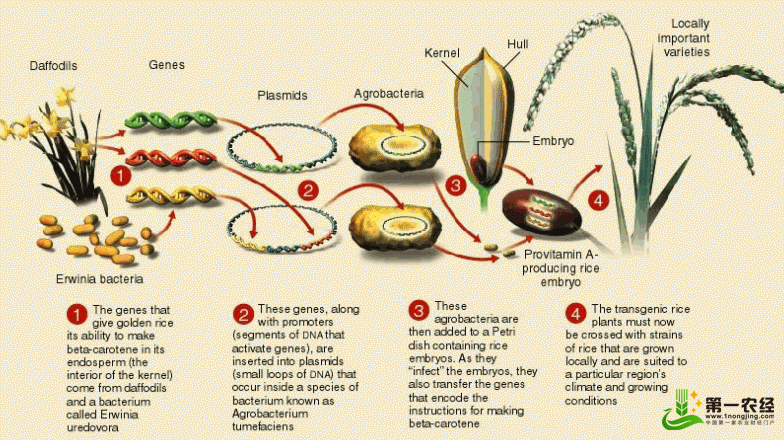The synthetic route of carotene in plants contains six elements: IPP/DMAPP isomerase, GGPP synthase, phytoene synthase, phytoene dehydrogenase, ruthenium-carotene dehydrogenase and Lycopene α-β-cyclase. Because rice itself has IPP/DMAPP isomerase and GGPP synthase, researchers need to transfer the latter four into rice...
Bio-communication report: The report on "Golden Rice" (GMO rice, GR) has recently caused an uproar. The latest development is related to the article (β-Carotene in Golden Rice is as good as β-carotene in oil at Provide vitamin A to The second, third and fourth authors (both Chinese authors) denied having participated in the study, saying that “no previous information about the paper has been heard, nor has the content of the paper been read. I don't even know why my name will appear in the author of the paper. The progress of the event is confusing. Before we go any further, let's first take a look at what this genetically modified rice called "Golden Rice" is. What is the use of transgenic technology, which foreign genes may be brought in, causing harm?
Click on the Golden Rice Project project page, which details the initial development of this genetically modified rice, pointing out that Professor Ingo Potrykus and Peter Beyer (breeding experts and molecular biologists, respectively) at the Swiss Federal Institute of Technology in Zurich are the mechanism of action of this rice. The founder of the rice rights association in 2000 established a partnership with Syngenta Agricultural Company to start further research such as field trials. Syngenta (Syngenta) is a Swiss agricultural and chemical giant who developed the rice and tested it in the United States in 2004. The R&D company claims that the main function of this rice is to help the body increase vitamin A absorption, and the lack of vitamin A may lead to night blindness. At present, Syngenta has denied participation in the research of the above papers.
The first generation of "golden rice" was introduced in 2000, using the gene from daffodil, which contains about 1.6 mg of carotene per gram of rice, which is pale yellow. The second generation of "Golden Rice" was introduced in 2005 and was produced using the corresponding genes in corn, mainly obtained by transgenic technology to transfer the carotene invertase system into rice endosperm, which is golden yellow.

Carotene is a synthetic vitamin A material. The body can only synthesize vitamin A by absorbing carotene. In ordinary rice, the content of vitamin A or carotene is zero. The natural hybridization method cannot make rice rich in vitamins. Because hybridization requires a trait that we need in a female parent, however, until now, agronomists have not found any rice containing vitamin A or carotene as a breeding mother, so the genetic modification method was adopted.
The main steps are as follows:
The synthetic route of carotene in plants contains six elements: IPP/DMAPP isomerase, GGPP synthase, phytoene synthase, phytoene dehydrogenase, ruthenium-carotene dehydrogenase and Lycopene α-β-cyclase. Since rice itself has IPP/DMAPP isomerase and GGPP synthase, researchers need to transfer the latter four into rice.
The researchers obtained phytoene synthase and lycopene α-β-cyclase from the flowers of Daffodil daffodils, which have the effect of regulating the color of the flowers, and from the soil bacteria Erwinia (E. Bacterial carrot dehydrogenase is obtained in Salicis) and is mainly used to convert phytoene into lycopene. This produced the first generation of golden rice.
Later, in order to increase the content of carotene, the researchers found that the phytoene synthase of daffodil is not conducive to the formation of carotene, so the phytoene synthase from corn was used to breed the second generation.
In these processes, in addition to the above-mentioned genes for the synthesis of carotene, as well as the agrobacterium tumefaciens (Agrobacterium tumefaciens) as a vector, Agrobacterium-mediated genetic transformation is currently widely used in plant transgenic research.
References:
Beyer P et al. Golden Rice: Introducing the ß-Carotene Biosynthesis Pathway into Rice Endosperm by Genetic Engineering to Defeat Vitamin A Deficiency. The Journal of Nutrition, 2002, 132:506S-510S. Biotech
Granular Activated Carbon,Wastewater Treatment,Water Filtration
Coal-Based Activated Carbon,Activated Carbon Co., Ltd. , http://www.nbactivatedcarbon.com